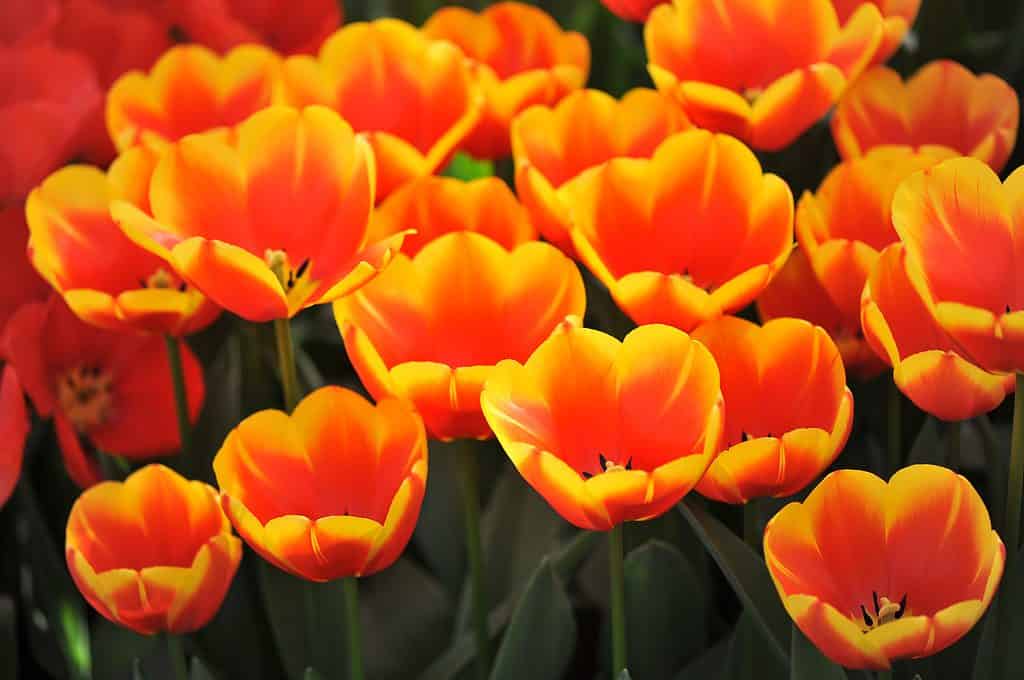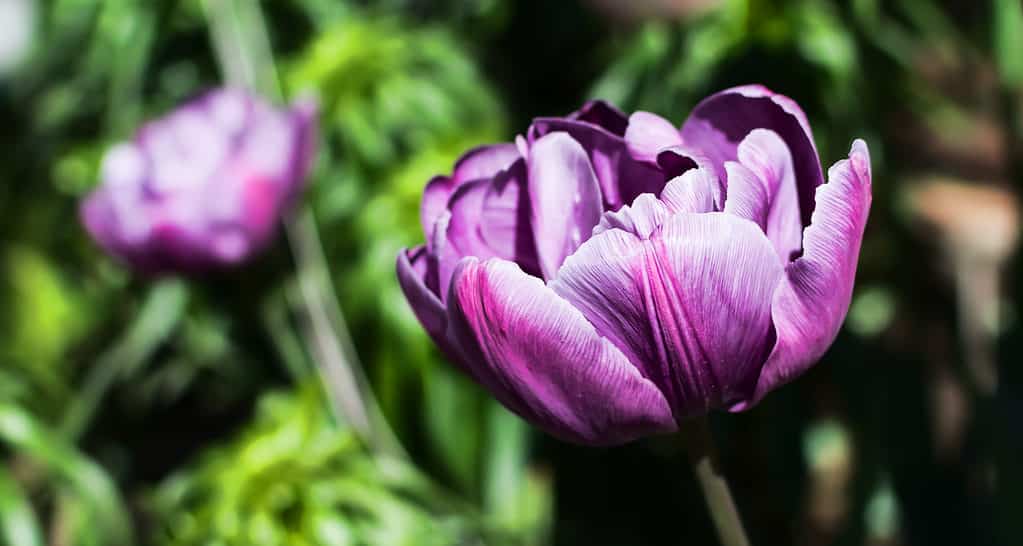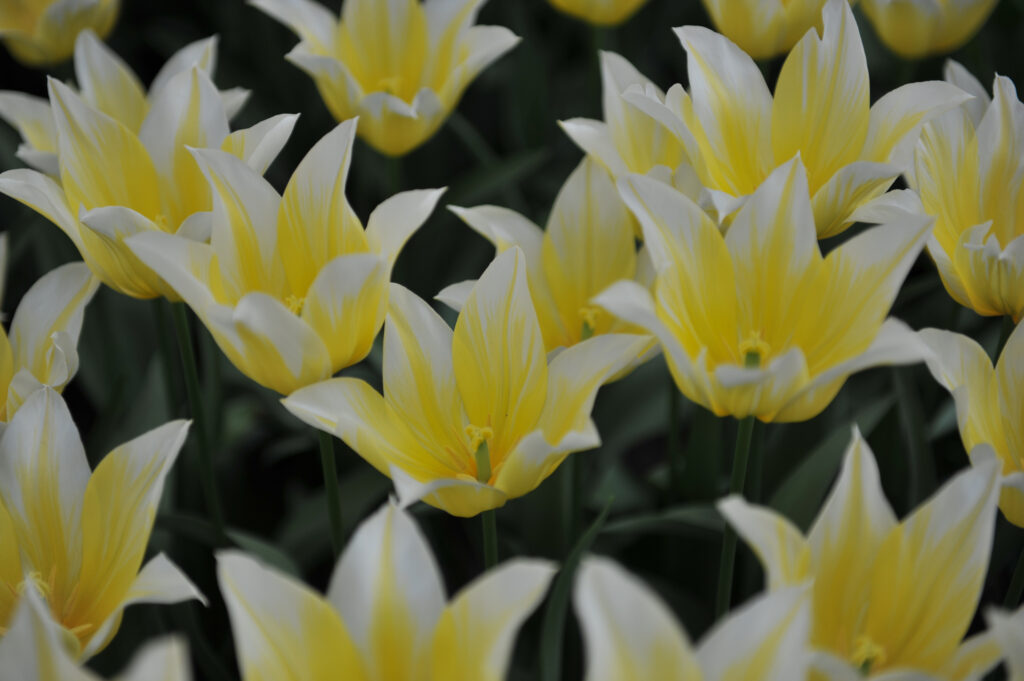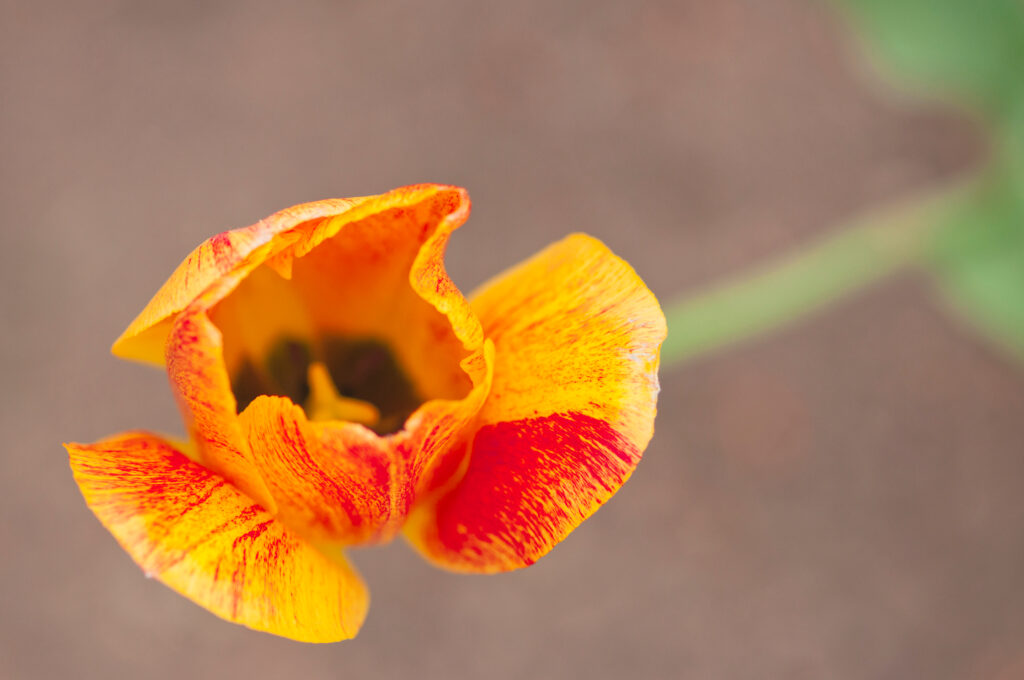| Tulip Facts | |
|---|---|
| Botanical name | Tulipa spp. |
| Common Name | Tulip |
| Plant Type | Perennial, bulb |
| Soil | Rich, well-drained |
| Bloom Season | Spring |
| Toxicity | Toxic to both humans and pets |
Seemingly everyone loves tulips because, well, what’s not to love? The colors are vibrant and dazzling. The low pollen count doesn’t aggravate allergies. They are wonderful for gardens in cooler plant hardiness zones where other plants struggle. And, possibly best of all, they signal the arrival of spring. A colorful tulip display reminds us the gray winter drear is over.
These spring flowers are so beloved that entire festivals organize to celebrate their arrival. The largest tulip festival in the United States happens each May in Holland, Michigan. This small city is covered with the colorful blooms of four million tulips every spring!
But, as fun and memorable as they are, the tulip is not only celebrated in huge festivals. The most special tulip celebration is the one that happens in your own garden or flowerbed. That, however, raises a question. Which tulips should you choose to create a spectacular spring display? It can be a bit daunting since there are around 150 species with more than 3,000 cultivars in the Tulipa genus. For many gardeners, there are just too many tulip choices!
Let’s narrow things down by exploring 11 of the most popular types of tulips. There are very good reasons why these tulip groups and cultivars have become so wildly popular. Some of these varieties are sure to be perfect selections for your landscape.

The Tulip Time Festival in Holland, Michigan, is the largest tulip festival in the United States.
©iStock.com/csterken
1. Darwin Hybrid Tulips
- USDA Hardiness Zones: 3-8
- Height: 20-34 inches
- Sun Exposure: Full
Darwin hybrid tulips were developed in the Netherlands by D.W. LeFeber. He crossed the red emperor tulip with other cultivars that were known as Darwin tulips. The result was a tulip variety that is one of the most popular on the market today.
Darwin hybrids are some of the tallest-growing tulips, reaching heights of up to 34 inches. When a tulip reaches nearly three feet tall, it’s going to be an attention-getter!
But it’s not just the height that makes the Darwin hybrid tulip so populait’she stems are tough and sturdy. They can withstand the wind and rain of a strong spring storm.
Darwin hybrid tulips are available iit’srainbow of colors, including white, orange, yellow, pink, red, and bi-color, as well as speckled and striped.

Darwin hybrid tulips, such as this beautiful orange-yellow variety, are some of the most popular tulips today.
©Sergey V Kalyakin/Shutterstock.com
2. Triumph Tulips
- USDA Hardiness Zones: 3-8
- Height: 18-20 inches
- Sun Exposure: Full
This is the largest tulip group on the market. The Triumph group also features some of the most classically-shaped cupped blooms so often associated with tulips.
Triumph tulips were developed through a cross between the original Darwin hybrid tulip and single early tulips. They don’t grow as tall as Darwin hybrids, but triumph tulips feature the same stout stem that can hold up to wind and rain.
These single-petal flowers are available in an array of brightness and color. If you wantdon’t, vibrant colors, they are easy to find. Are pastels more your thing? Triumph tulips have you covered. Looking for bi-color blooms? Triumphs have those, too.
And, perhaps best of all, these tulips are low-maintenance and highly reliable flowers. If you’re looking for an easy-to-grow tulip, the triumph tulip may be your answer.

The Triumph tulip, such as these red and yellow varieties, are among the most widespread and popular of all the tulips.
©Alex Manders/Shutterstock.com
3. Peony Tulips
- USDA Hardiness Zones: 3-8
- Height: 16-18 inches
- Sun Exposure: Full, Partial
Peony tulips are a type of double late tulip. Double, meaning they have a lot more petals than other tulips. Late, meaning they bloom later in the spring than other tulip varieties.
These showy flowers resemble peonies, hence their common name. The blooms on these tulips are impressive, measuring close to four inches across. Peony tulips are available in white, purple, yellow, red, pink, orange, and white. There are also bi-color and multi-color varieties that can add even more visual interest to your display.
Peony tulips are not as stout as Darwin hybrids. A site that has a built-in windbreak can help these more delicate tulips stand up to unpredictable spring weather.

Purple peony tulips have more petals than other tulips and may measure up to four inches across.
©Lena Maximova/Shutterstock.com
4. Fosteriana (Emperor) Tulips
- USDA Hardiness Zones: 3-8
- Height: 14-20 inches
- Sun Exposure: Full
Fosteriana tulips are also commonly referred to as “emperor tulips” due to their large flowers. These oversized blooms feature vibrant colors, including white, yellow, orange, red, and pink, along with some stunning bicolor varieties.
Fosterianas are some of the earliest-blooming tulips each spring. If you want bold, early-season color, check them out.
These tulips seem to be more popular in Europe than in the United States, so U.S. gardeners could use Fosterianas to create a display that is unique in their neighborhoods.
And, speaking of uniqueness, check out this next tulip.

These bright orange Fosteriana tulips are sure to impress with their bold colors.
©Kazakov Maksim/Shutterstock.com
5. Parrot Tulips
- USDA Growing Zones: 3-8
- Height: 14-22 inches
- Sun Exposure: Full
These tulips feature some of the freest and wildest color patterns of any spring flower. They seem to break all the rules in the best possible ways.
Parrot tulips were developed through a mutation of some late and triumph tulip varieties. Because they come from late tulips, they bloom later in the season than many other varieties.
These exotic-looking tulips feature a variety of colors and patterns. Some are bi-color. Others more closely resemble a tie-dye t-shirt.
The fancy, ruffled petals twist, curl, and feather as the flowers mature. In the end, every parrot tulip bloom is like a fingerprint. No two are exactly the same.
The one knock on these distinctive tulips may be their delicate nature. These tulips are not wind or storm-hardy flowers. When planting parrot tulip bulbs in the fall, choose a site that will be protected from strong spring weather.

These rainbow Parrot tulips are showing off their exotic-looking ruffled petals and tie-dye coloring.
©Oxana Bazarova/Shutterstock.com
6. Kaufmanniana Tulips
- USDA Growing Zones: 3-8
- Height: 6 inches
- Sun Exposure: Full
The diversity among tulip varieties and cultivars is really amazing. Case in point, while the Darwin hybrid tulip can grow to nearly three feet tall, the diminutive Kaufmanniana tulip only reaches heights of six inches at maturity.
Kaufmanniana tulip blooms provide a lot of interest, giving two completely different looks depending on the conditions. When the sun is bright, the star-shaped flowers will open wide, displaying their colorful petals and contrasting centers. On an overcast day, the blooms will remain closed and will display an entirely different look and color.
Kaufmanniana tulips bloom early in the spring and are available in a variety of solid and bi-color combinations of rose, pink, red, purple, golden yellow, and orange.

Kaufmanniana tulips display very different looks depending on the weather.
©Orest lyzhechka/Shutterstock.com
7. Fringed Tulips
- USDA Hardiness Zones: 3-8
- Height: 16-26 inches
- Sun Exposure: Full
“Fringed tulips feature serrated or “fringed” edges on the petals, allowing these flowers to really stand out in the rather crowded tulip community. Once considered more of a novelty flower,”the fringed tulip is growing in popularity due to its uniquely beautiful fringed blooms. The fringes look a bit like frost on a windowpane.”Fringed tulips feature serrated or “fringed” edges on the petals, allowing these flowers to really stand out in the rather crowded tulip community. Once considered more of a novelty flower, the fringed tulip is growing in popularity due to its uniquely beautiful fringed blooms. The fringes look a bit like frost on a windowpane.
The group of fringed tulips includes mutations from multiple other tulip groups, so blooming times can vary among the different fringed tulips. However, most will bloom in mid-late spring.
These tulips feature a color range of white, yellow, red, pink, purple, and bi-colored. In addition, the petals often feature a contrasting color on the ends, adding even more to their visual interest.

Fringed tulips have uniquely beautiful serrated petals that make them stand out.
©Sergey V Kalyakin/Shutterstock.com
8. Lily-Flowered Tulips
- USDA Growing Zones: 3-8
- Height: 16-24 inches
- Sun Exposure: Full
This tulip is so-named because its pointed petals resemble those of a lily. The slender goblet-shaped flowers add an elegant look to your display. The delicate blooms are also popular in bouquet arrangements.
These tulips grow tall, reaching heights of two feet at maturity. The stems are not sturdy, though. The petals are also quite delicate. A brisk spring wind can blow the petals off or snap the stems, bringing these lovely blooms to an early demise. A windbreak is essential to protect these dainty flowers.
The color variety in the lily-flowered tulip class is impressive. You can find these tulips in white, yellow, orange, red, purple, pink, and bi-colored varieties. Some feature multi-colored swirls, as well.

Lily-flowered tulips are known for their pointed petals and goblet shape.
©Sergey V Kalyakin/Shutterstock.com
9. Greigii Tulips
- USDA Growing Zones: 3-8
- Height: 8-12 inches
- Sun Exposure: Full
The Greigii tulip features a bowl-shaped bloom that displays warm, often two-toned shades of red, pink, white, orange, and/or yellow.
Greigii tulips are short-mid-sized tulips, growing about a foot tall at maturity. They bloom in early-mid spring, and the blooms tend to stick around for a while. Greigii tulips feature one of the longer blooming seasons among all tulip varieties.
Considering its shorter stems, the blooms of the Greigii tulip are quite large by comparison. In fact, the Casa Grande (a tulip in the Greigii group) features what is possibly the largest bloom of any tulip. The tomato-red bloom of the Casa Grande can grow to over four inches across.

Greigii tulips are often two-toned and feature a bowl-shaped bloom.
©Sergey V Kalyakin/Shutterstock.com
10. Single Early Tulips
- USDA Growing Zones: 3-8
- Height: 10-14 inches
- Sun Exposure: Full
Per their name, single early tulips bloom early in the season. In most zones, the blooms appear in March. If the brown grass and leafless trees of winter get you down, single early tulips can bring a burst of spring color to your landscape before most other tulips. Those colors include white, red, pink, purple, apricot, orange, yellow, and bi-colored options. If you have daffodils, single early tulips bloom at roughly the same time. Combining the two creates a wonderful early-season display.

This single early tulip provides a cheerful boost of color in March.
©Liviu Gherman/Shutterstock.com
11. Single Late Tulips
- USDA Growing Zones: 3–8
- Height: 16–30 inches
- Sun Exposure: Full sun
Single late tulips are among the most warm-weather-tolerant tulips on the market. While the official growing recommendation is for Zones 3-8, growers in even warmer zones have success with single late tulips. This is especially true with one particular variety, the French single late tulip. If you live in a warm hardiness zone, the French single late is certainly a tulip to try in your garden.
Single late tulips are long-stemmed tulips that can stand their ground in the face of wind and rain. They come in an array of colors. You can find single late tulips in white, pink, yellow, and nearly black.
There is even a sub-category of single late tulips, which feature four or more flower stalks per plant. These multi-flowering single lates give you more bloom for your buck, to be sure.

French single late tulips come in a rainbow of colors, including orange and pink.
©ISmiths/Shutterstock.com
Which One Is Best for You?
Personal preference is the main driver when choosing between the different tulip varieties. Do you want bright or muted colors? Tall or short flowers? Classic tulip blooms or something entirely different? You can find it all in the big, beautiful world of tulips.
The photo featured at the top of this post is © Sergey V Kalyakin/Shutterstock.com
Thank you for reading! Have some feedback for us? Contact the AZ Animals editorial team.






